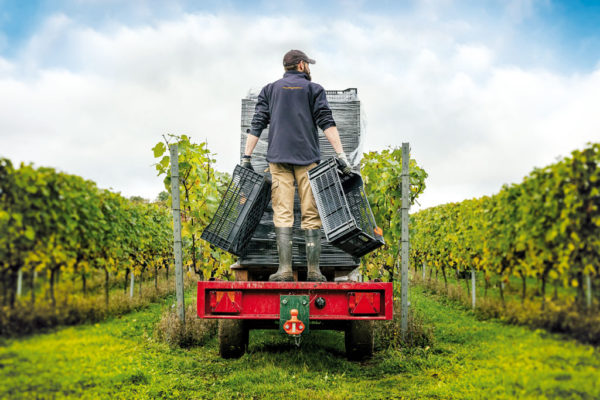Chateau Figeac, The New Star Of Saint Émilion – Review
By
2 years ago
Explore one of Saint Émilion's most celebrated estates

Richard Hopton heads to Chateau Figeac, a glorious estate with a brand new winery.
Chateau Figeac, The New Star Of Saint Émilion – Review

Image credit: Alain Benoit
Chateau Figeac, one of Saint Émilion‘s most celebrated estates, boasts a long history. The name traces its origins to the 2nd century AD when a Gallo-Roman villa stood on the site but vines have been grown here since at least the sixteenth century. The elegant chateau which stands at the centre of the estate dates from the last years of the 18th century. The Manoncourt family, owners of the estate since 1892, has constantly improved the quality of the wine through minute but unwavering attention to detail. Despite this long and distinguished past, the last two years nonetheless represent a significant moment in Figeac’s history.
In September 2022, Figeac was promoted to join the highest rank of Saint Émilion’s classification of wines, Grand Cru Classé ‘A’, thereby joining the grand dukes of the appellation, Chateaux Angelus, Ausone, Cheval Blanc, and Pavie. This promotion was recognition of the exceptional character, quality and consistency of Figeac’s wines over many vintages.
The 2021 vintage was notable as the first to be produced in the magnificent new winery. The 5000-metres-squared building combines the latest technology with a felicitous design which minimises the visual impact of the structure in the landscape by sinking it into the ground. This allows the 18th century chateau to retain its time-honoured dominance over its surroundings.
The incorporation of many elements of the old building in the new – for example, the former Renaissance cellar was dismantled and the stones reused – is an aesthetic triumph which reflects the Manoncourt family’s determination to minimise the impact of human activity on the environment. Figeac comprises a single block of 54 hectares – a large estate by the standards of Saint Émilion – of which 41 hectares are planted with vines. Much of the rest of the land is the estate’s ‘green spine’ – a registered wildlife reserve – consisting of woods, meadows, an orchard, a vegetable garden, parkland, and a lake which between them provide habitats for a wide range of flora and fauna. There are also 3 kilometres of hedges on the estate. Such biodiversity is unique among wine estates in Saint Émilion and exerts a vital influence on the character of Figeac’s wines.

Image credit: Raphael Zimmermann Oryx
The design of the new winery is both beautiful and functional but was determined from the outset by the technical requirements of modern winemaking. Eight French oak vats and 40 blunt-nosed conical stainless steel vats allow the variety and subtlety of Figeac’s terroir to be more accurately reflected in the wines. Formerly, there were perhaps 25 samples of wine from the three grape varieties used in the blending process; now there are typically 45.
The new building includes two tasting rooms with fine views over the vineyards and into the winery, two subterranean barrel rooms, and a cellar for storing the family’s collection of historic Figeac vintages which date back to the late 19th century. The west wing of the chateau itself has been remodelled to form a large entertaining space consisting of a music room and a drawing room. The new winery is designed to be as energy efficient as possible and to provide an agreeable working environment for Figeac’s staff. For example, the subterranean barrel rooms are lit by natural light: ‘The human aspect of sustainability should not be forgotten,’ says Blandine de Brier Manoncourt.
Ultimately, Figeac’s reputation will stand or fall on its wines and they are fabulous. The estate has been blessed with an unusual geology: three gravel hills set upon different types of subsoil overlaying blue clay. The Figeac vineyards have four identifiable microclimates as well as reaping the ecological benefits of the estate’s ‘green spine’. ‘Our purpose,’ says Mme. de Manoncourt, ‘is to serve the terroir and the wine.’
Figeac’s wine is a blend of cabernet sauvignon –a grape not usually found in Saint Émilion – cabernet franc and merlot. As the wines age, they grow in complexity and reveal different aspects of themselves, developing different characters – in some cases markedly so – which reflect the unique conditions of each vintage.

Hotel Grand Barrail
During my visit I stayed at Hotel Grand Barrail, just across the road from Chateau Figeac. It is a glorious early twentieth-century pastiche in honey-coloured stone of a sixteenth-century chateau. The hotel sits on the edge of the vineyards of the neighbouring Chateau La Marzelle, another Saint Émilion Grand Cru Classé estate. Grand Barrail has been a hotel since 1993 but has now been extensively and luxuriously refurbished. Nine of the 46 rooms are in the original chateau, the remainder being located in various annexes in the grounds. There is also a spa and wellness centre.
The hotel’s peaceful grounds include a small lake, home to a pair of swans. The garden front is planted with a quartered wild flower meadow, bordered by roses and trimmed evergreen bushes. It is a haven of tranquility, a stolen moment of douceur de vivre, away from the hectic world beyond.
To find out more about Chateau de Figeac, visit chateau-figeac.com. To find our more about Hotel Grand Barrail, visit grand-barrail.com.






